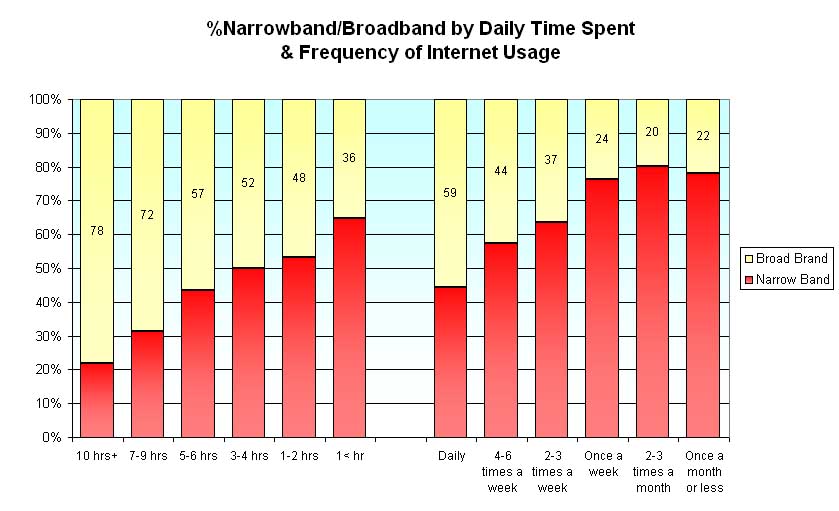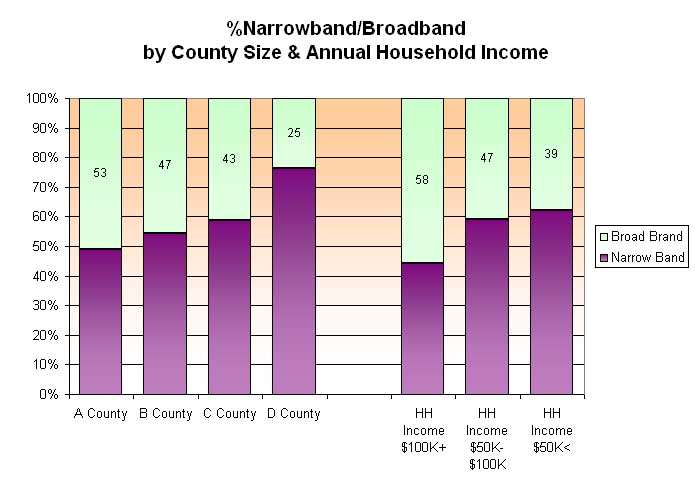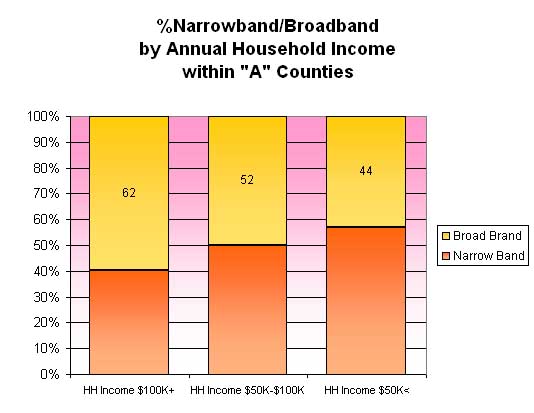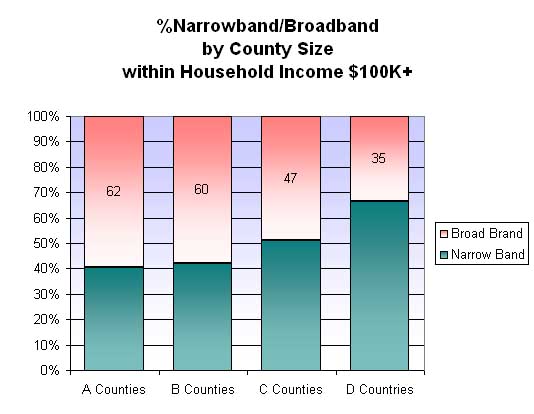
(Source: 2004 MARS study; base: Internet home users)
Universal Broadband Access
At first, intenet access from home was usually made through using telephone modems that work at low speed (at a maximum of 56 kbps). In time, the internet service providers were able to figure out that the telephone phone wire contains much larger capacity, and so an alternate DSL service could be provided without interfering with regular voice telephony. Meanwhile, cable television operators also realized that their cable wires could also be used to provide internet access. Collectively, these high-speed methods of internet access are known as broadband, in contrast to the low-speed narrowband access.
While all internet users access the same basic services (electronic mail, world wide web, file transfer protocol, etc), the difference in access speed should lead to differences in user characteristics. Thus, one would guess that the broadband user can afford to spend more time (note: there is usually no restriction on broadband access time) and they can more readily engage in activities that require high-speed access (such as watching television on the world wide web). Previously, we had shown some comparisons of broadband vs. narrowband users for Argentina (see article).
In this article, we turn our attention to the United States. Our data source is the 2004 MARS study. This is a mail survey of 21,054 adults in the United States. Within this sample, 65% said that they have accessed the internet and 58% said that they accessed the internet from home. Among the home users, 55% said that they had narrow band 57% said that they accessed the Internet by narrowband and 46% by broadband. Note that the sum of broadband and narrowband exceeds 100% because dual modes is possible.
The survey respondents are asked about their daily time spent on the Internet and their frequency of usage. The relative percentages of narrowband/broadband acess are shown in the following chart. The more hours spent per day, the more likely that access mode is broadband. The more frequent usage, the more likely that access mode is broadband. This is just what was expected.

(Source: 2004 MARS study; base: Internet home users)
If broadband is so good, why doesn't everyone have it? There are two reasons. The first reason is cost. Typically, narrowband access costs around US$20 per month whereas broadband access ranges anywhere between US$30 to US$60, with additional cost for multiple access points. The second reason is availability. This is just like the situation with telephony. In the high-density urban areas, the telephone companies can lay down the fiber optic cables and know that they stand a reasonable chance to recuperate costs and even make profits. In the low-density rural areas, they know that there is no way to run a profitable operation, ever. To guarantee universal telephone access, the telephone companies charge higher in the urban areas to subsidise rural users. The subsidy was possible when telephony was a regulated monopoly. When cable television came along, the same situation exists, but there was no reason to guarantee universal access to an entertainment service. Thus, much of the rural America does not have cable television. Internet access is now following the historical path of cable television.
In the following chart, we look at these these factors. On the right hand side, we have the relative percentages of narrowband/broadband access by income. As income goes up, broadband access is more likely. On the left hand side, we have the relative percentages of narrowband/broadband access by county size. The United States is divided into approximately 3,300 counties with the following county size designations: (A) one of the largest 21 counties in the country; (B) metropolitan areas or more than 85,000 households according to the 2000 Census; (C) county which has more than 20,000 households or is part of a metropolitan area [MSA] that has more than 20,000 households; (D) county with less than 20,000 households. The data here show that broadband access is goes down with country size.

(Source: 2004 MARS study; base: Internet home users)
The next chart on the left below shows that even within the "A" countries, where we assume that broadband coverage is universal, broadband access increases with household income. The chart on the right shows even within the upper income households, where we assume that cost is irrelevant, broadband access is significantly less in "D" counties.


(Source: 2004 MARS study; base: Internet home users in
"A" counties)
In a Newsweek article titled Broadband in Every Pot (May 14, 2004) by Jonathan Darman, the subject of universal broadband came up:
Broadband policy has become an issue for both Kerry and Bush, who have each made grand promises of expanded access to high-speed Internet. In a recent speech, the president called for broadband access in “every corner” of America by the year 2007. Kerry, who has yet to unveil a specific broadband policy, has hinted that making high-speed access universal would be a priority in his administration.
Bush and Kerry are simply the highest profile in a long line of politicians who have come to realize that promises of faster Internet service resonate with voters interested in modernizing the American infrastructure and improving the efficiency of the economy. What’s more, unlike so many campaign pledges, dramatic increases in broadband access in the short term are actually feasible, according to some experts. “It’s a reasonable goal,” says David Gabel, an economist at the City University of New York who’s written about the broadband market. “The technology’s been improving that allows people to increasingly provide products at lower and lower costs.”
The devil, of course, is in the details. Anyone who lives in heavily populated urban and suburban areas can attest to the tremendous surge in broadband availability in recent years. As cable television and local phone-service providers watched their market share plummet with the advent of wireless and satellite technology, they turned to high-speed Internet as a way of staying relevant in consumer life. As their competition drove prices down, many home Internet users living near urban centers abandoned dial-up for a high-speed connection.
But outside of heavily populated areas, the transition to broadband looks less like a revolution than an underattended high-school pep rally. The ’90s telecom boom, in which service providers emptied their coffers to put fiber-optic connections in the ground, never trickled out to scantly populated areas and, under the existing structure, local phone companies say further expansion makes little economic sense. “The real problem is in the rural areas that are served by Verizon, SBC, Quest and Bell South because they face less competition from cable in these areas …” says Gabel. “The return on an investment is going to be much greater in an urban area than it is in a rural area.”
Try explaining that, however, to the people who live in those rural areas. Denied fast Internet connections, these consumers see themselves on the wrong side of the digital divide. Their dissatisfaction goes beyond a psychic slight; in a world that seems to increasingly value productivity and speed, rural policymakers worry that lack of broadband access is leaving their areas out of the market for high-paced, high-paying jobs.
It’s that kind of anxiety, in part, that makes candidates pay a good deal of lip service to rural telecommunications policies. Bush’s plan is market-based--calling for deregulation on broadband spectrum and providing tax breaks to companies implementing a broadband infrastructure. Kerry is expected to advocate a universal access fee on households in heavily populated area that would be used to subsidize rural expansion of a more heavily regulated broadband market.
The divergence in the two candidates' approaches will probably have little effect on all but the smallest sector of voters. But as more Americans start to make a mental link between the efficiency of the country’s economy with the speed with which they can access the Internet at home, politicians of the future could be forced to get more specific about expanding broadband policies on the stump. Of course, even if Bush or Kerry does deliver universal access in the next four years, he won’t have necessarily turned the U.S. economy into a lean, mean fighting machine. As Gabel points out, “If all we’re doing is providing subsidies so that people can have faster e-mail access or play more games at home, I’m not so sure that it does much to improve the productivity of our nation.”
(posted by Roland Soong, 5/16/2004)
(Return to Zona Latina's Home Page)